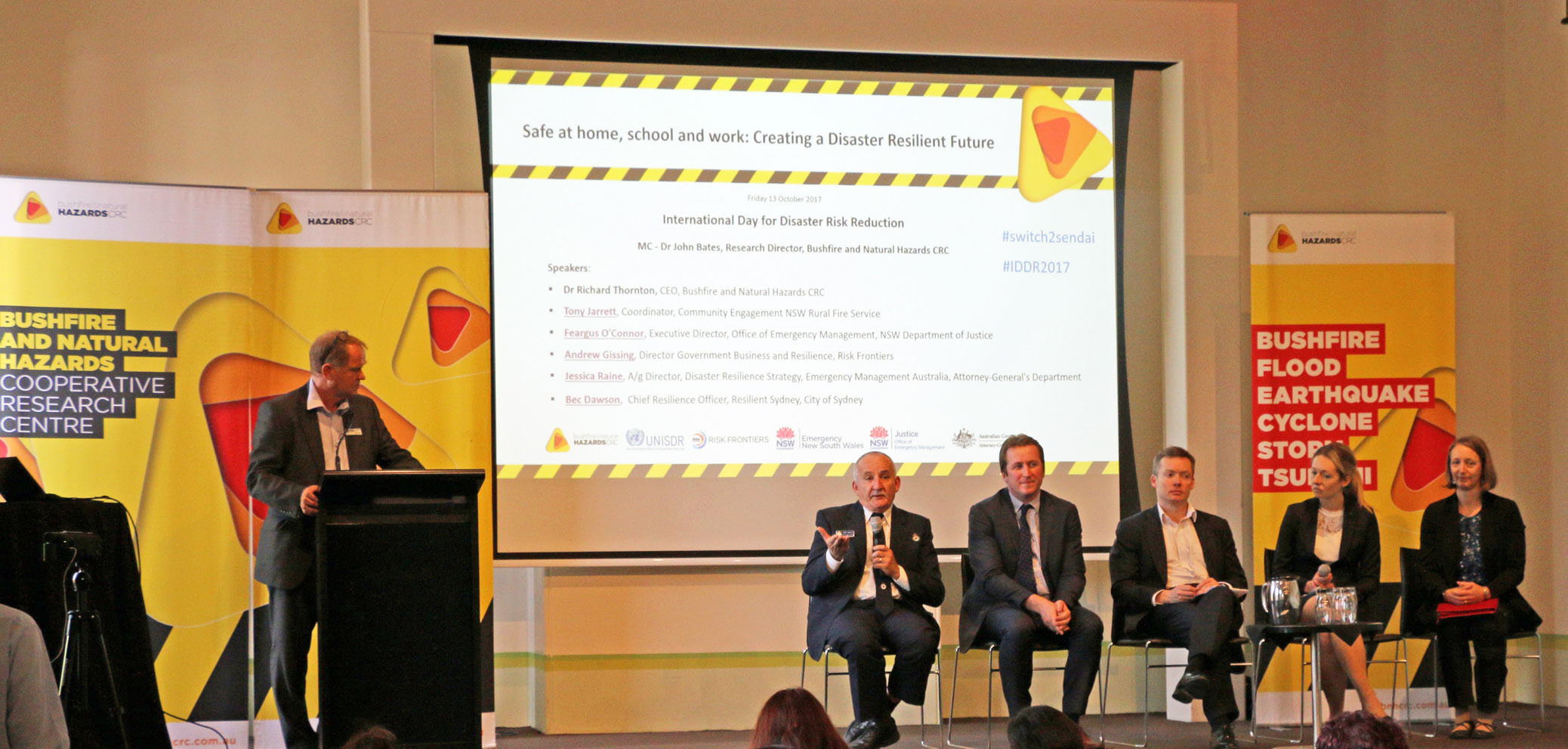On International Day for Disaster Reduction (IDDR) 13 October, the Bushfire and Natural Hazards CRC gathered nearly 50 emergency management practitioners and researchers in Sydney to reflect on how at-risk communities are reducing their exposure to disasters.
IDDR began in 1989, after a call by the United Nations General Assembly for a day to promote a global culture of risk-awareness and disaster reduction. Held every 13 October, the day celebrates how people and communities around the world are reducing their exposure to disasters and raising awareness about the importance of reining in the risks that they face. The theme of the 2017 IDDR continued the ‘Sendai Seven’ campaign, centred on the seven targets of the Sendai Framework for Disaster Risk Reduction 2015-2030. This year the focus was on Target B, ‘reduce the number of people affected by disasters by 2030’.
At the Sydney forum, speakers addressed a diverse range of topics, from understanding Australia’s obligations to the Sendai Framework to local public school initiatives.
Tony Jarrett, Community Engagement Coordinator at NSW Rural Fire Service (NSW RFS), spoke of the need to apply research and evidence-based practice from around the world in Australian schools. He noted that while every school had an emergency plan, NSW RFS was helping schools examine how robust these plans were. Schools could achieve this by asking questions like: Can schools emergency plans deal with a fast onset events? Are shelter in place options well thought through? How are students involved in emergency planning? Are drills looking at historical events or worst-case scenarios or just done in a rote fashion?
The challenge of moving from hazard-specific and response-focused emergency strategies was furthered by Feargus O’Connor from the Office of Emergency Management NSW. Mr O’Connor spoke of the move for the OEM to the development of consequence management strategies. Part of that involved expanding the groups the OEM engaged with in recovery and understanding community capability.
‘At the moment recovery is a cold start. We have no idea under the current emergency planning arrangements who’s out there that we want to talk to. We have no idea who the local business chamber is, what they can do or other social welfare and community groups. They’re part of the consequence management and recovery arrangements and the two parts need to be brought together,’ Mr O’Connor said.
Andrew Gissing, project leader at the Bushfire and Natural Hazards CRC and Director Government Business and Resilience at Risk Frontiers, spoke of what a catastrophic disaster in Sydney might look like, including overwhelming scale, uncertainty and the possibility of cascading events from the main disaster event.
Taking the big picture perspective was Jessica Raine from Emergency Management Australia. Ms Raine spoke on Australia’s commitments to the Sendai Framework and the opportunity presented for Australia to reflect on how its policies in disaster resilience and risk reduction perform. She explained Australia will be expected to report against the indicators from March 2019. Current reporting challenges include the availability of data, making new data nationally consistent and consistent across the reporting period to 2030.
Emergency Management Australia is working with states and territories to build a roadmap for reporting with data collection trials to begin in early 2018. Other opportunities to grow engagement with the Sendai Framework include support for the National Platform for Disaster Risk Reduction and establishing a Sendai Champions Network.
Rounding at the forum was Beck Dawson, Chief Resilience Officer for the City of Sydney. Part of the 100 Resilient Cities program, Ms Dawson reaffirmed that resilience is about people. She discussed the challenges for Sydney in embedding resilience thinking.
‘How do we get five million people thinking about these issues?’ she asked. ‘How do we connect all the dots to make it sensible and useable?’
Within a risk cocktail of urbanisation, globalisation and climate change, Ms Dawson noted that there are a number of things those involved with disaster resilience need to get better at including strong leadership, community engagement, measuring progress and making investment decisions that work for diverse and multiple outcomes.



